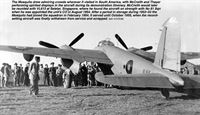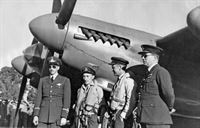Фотографии
-
Регистрационный номер: VL613 [4] Mosquito VL613 at Moron after its arrival in Argentina on October 2, the local newspapers reporting it as “the end of a misadventurous flight”. Partly obscured by the Mosquito’s fin is a Braniff Airways Douglas DC-3 sent from the USA to demonstrate Sperry autopilot equipment to the Argentinians during the Buenos Aires exhibition.
Самолёты на фотографии: De Havilland Mosquito PR - Великобритания - 1941Douglas DC-3 / C-47 Skytrain/С-53 Skytrooper / Dakota - США - 1935
-
Resembling a less refined Mosquito, after which it was patterned, the IAe 24 Calquin twin-engined tactical bomber was a prime candidate for the supply of surplus Rolls-Royce Merlin engines from the UK, but the type was ultimately fitted with Pratt & Whitney Twin Wasp radials instead. A total of 100 production examples was built by IAe.
Самолёты на фотографии: FMA IAe.24 Calquin - Аргентина - 1946
-
Регистрационный номер: VL618 "Москито" PR.34 в полете
Mosquito VL618 was part of the same batch of 13 de Havilland-built PR.34s as RG300’s replacement, VL613. For optimum performance, the Mosquito cruised at 360 m.p.h. (580km/h) at 30,000ft (9,150m), at which the oxygen lasted 9hr. Dropping to 20,000ft (6,100m) would give 12hr of oxygen but a reduction in economy and speed.Самолёты на фотографии: De Havilland Mosquito PR - Великобритания - 1941
-
Регистрационный номер: GR300 The first Mosquito despatched to Buenos Aires for the aeronautical exhibition in October 1946, PR.34 RG300, undergoes final preparations at Benson before setting off on the first leg of its transatlantic flight on September 22 that year. Unfortunately it came to grief after landing at RAF Yundum in The Gambia the following day.
Самолёты на фотографии: De Havilland Mosquito PR - Великобритания - 1941
-
Регистрационный номер: RG300 [2] Hatfield-built Mosquito RG300 is pushed out of its hangar at Benson on September 22, 1946. The PR.34 was a long-range high-altitude photo-reconnaissance variant intended for use in the Far East, where it was expected that there would be a requirement for such a variant in the forthcoming campaign against the Japanese.
Самолёты на фотографии: De Havilland Mosquito PR - Великобритания - 1941
-
Регистрационный номер: VL613 [4] A poor-quality but rare image of VL613 at Galeao airport, now Antonio Carlos Jobim Airport in Rio de Janeiro, Brazil. Taken during the aircraft’s visit to South America in October-November 1946, it is possibly seen here during its extended stay there on its return journey to the UK.
Самолёты на фотографии: De Havilland Mosquito PR - Великобритания - 1941
-
Регистрационный номер: VL613 [4] Argentinian military staff at BAM Coronel Pringles, near Villa Mercedes, pose with VL613 on October 11, during McCreith and Thayer’s demonstration tour of air bases with the Mosquito.
Самолёты на фотографии: De Havilland Mosquito PR - Великобритания - 1941
-
Регистрационный номер: RG300 [2] Last-minute adjustments are made to RG300 at Benson before the flight on September 22. Powered by "handed" Merlin 113 and 114 engines, the PR.34 had a potential range of more than 3,500 miles (5,600km), achieved by fitting an overload fuel tank in the bomb bay and doubling the size of the wing tanks.
Самолёты на фотографии: De Havilland Mosquito PR - Великобритания - 1941
-
McCreith and Thayer depart Benson on the afternoon of September 22. The PR.34 was a tricky aircraft to handle, and received a somewhat unfavouable report from test pilots during its acceptance trials. Some 181 were built, 50 by Percival at Luton.
Самолёты на фотографии: De Havilland Mosquito PR - Великобритания - 1941
-
Регистрационный номер: VL613 [4] The Mosquito drew admiring crowds wherever it visited in South America, with McCreith and Thayer performing spirited displays in the aircraft during its demonstration itinerary. McCreith would later be reunited with VL613 at Seletar, Singapore, where he found the aircraft on strength with No 81 Sqn when he was appointed the unit’s CO in August 1954. After a period in storage during 1952-53 the Mosquito had joined the squadron in February 1954. It served until October 1955, when the record-setting aircraft was finally withdrawn from service and scrapped
Самолёты на фотографии: De Havilland Mosquito PR - Великобритания - 1941
-
The reception for the Mosquito and its crew after their arrival at Buenos Aires. From left to right: Teniente Rafael Gandolfo of the FAeA; Flt Lt Frederick Thayer; Flt Lt Stanley McCreith and Wg Cdr Walter Beisiegel, the British Air Attache in Buenos Aires. No Merlin sales resulted, but the FAeA did acquire Gloster Meteors in 1947.
Самолёты на фотографии: De Havilland Mosquito PR - Великобритания - 1941
Статьи
- -
- B.Cahill - The Mayaguez Incident
- B.Livingstone - Unbroken
- E.Wild - Say Cheese! (1)
- G.Baughen - 1939. Was the RAF ready to war?
- G.White - The world's first..?
- J.-C.Carbonel - Super-Caravelle atomique!
- J.Mesnard - Soldier of Misfortune
- J.Proctor - TWA's Skyliners
- K.Hayward - The one that got away
- M.Bearman - Going with the Flow?
- P.Davidson - Off the Beaten Track...
- P.Jarrett - Lost & Found
- R.Lezon - Southern Exposure
- S.Sumbodo - Garuda's 'Hamble Boys'










